In precision machining, reducing material waste is a critical objective for improving efficiency, lowering costs, and promoting sustainability. Excessive waste impacts profitability and the environment, making it essential to adopt smart techniques and tools. This detailed blog explores various strategies to minimize waste while maintaining top-notch quality in machining processes.
1. Optimize Design for Manufacturability (DFM)
The design phase is where waste reduction begins. Working closely with customers to optimize designs ensures that parts are easier and more efficient to manufacture.
-
How It Works:
- Simplify complex geometries to minimize unnecessary machining.
- Reduce excessive tolerances where they are not critical to function.
- Utilize CAD simulations to predict machining outcomes and avoid potential waste.
-
Real-World Example:
A company redesigns a part with fewer undercuts, reducing material removal by 20%.






























